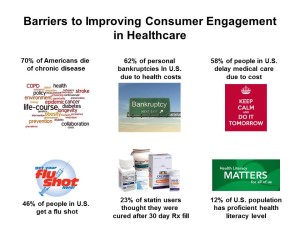
Patient and health engagement is the flavor du jour in health circles these days, from the corridors of hospitals to the caffeinated marketing meetings in Big Pharma’s east coast meet-ups. But there’s no standard agreement on what we mean by peoples’ health engagement, whether by patient or well consumer.
In Market Insights: The Evolution of Consumer Engagement in Health Care, Porter Research endeavors to deepen our understanding of this important concept.
In the introductory section of the paper, “Understanding Engagement,” Porter proffers that industry – providers, payers and employers – consider engagement as “changing consumer behavior through increased participation in consumers’ own health management.” Technology companies’ view is engagement in tech to benefit provider workflows and achieve Meaningful Use. Patients, Porter says, think of themselves first, considering their own “level of commitment” and how they want to better manage their health.
The company rightly says that patients are too often late-invited to the health engagement party, their needs overlooked until too-late in the design and product development cycle.
As health industry stakeholders move to circle the patient with products and services that better serve people, Porter quotes inVentiv’s George Van Antwerp (@gvanantwerp) on the barriers of health engagement, shown in the picture. As U.S. health financing moves from volume-to-value, aligning incentives toward patient and health outcomes, it’s incumbent on stakeholders to see people more effectively involved in self-care.
For providers: Given that reimbursement is declining from both government and private payers, promoting and supporting patients’ self-care is an important success factor. Porter Research talks about patient portals as one channel for health engagement as a push strategy, but recognizes that patient engagement is both push-and-pull.
For payers: Consumer engagement is important to payers as they deploy population health programs to help manage medical trend and resource utilization (e.g., generic fill vs. brand, and wellness program participation). A large barrier requiring education and support is up-front cost-sharing by patients, whether in high-deductible health plans or in spending on co-payments or coinsurance percentages.
For technology companies: Information and communication technology companies (ICTs) play a growing and quite central role in health engagement. Consumers use mobile phones and computers in daily life activities, and surveys indicate that a plethora of people are comfortable using self-service tech’s in health care – from e-refilling prescriptions to scheduling appointments online and tracking medication adherence.
Health Populi’s Hot Points: The “consumer” wears many hats in health care, Porter rightly points out: she’s a patient, a plan member, a clinical trial participant, a user of health tools and information. Porter doesn’t call out people as caregivers, but that is a growing role played by people, as well – and a cohort that’s getting younger as parents live to older ages.
Health engagement is every stakeholder’s job. Only through all of these stakeholders — payers, providers, tech companies, government agencies, life science companies, and employers – putting the person-patient-caregiver at the center of health and health care — will the health care system morph toward a health system, which aligns incentives for people to stay well. get well, and age well. This will require more than patient portals, which are largely the focus of the Porter Research paper. Portals are one of many tools in the health engagement toolbox that will be deployed in people engaging back with what has been a relatively unfriendly health system.
Many people who can stay out of the health system will do so for as long as possible. This will leave many sicker, less health-literate people needing a lot of help with health engagement. Providers, payers and government agencies should be ready for this challenge. It will be far heavier lifting than a physician prescribing a mobile health app for tracking calories, and asking people to strap on a wristband for monitoring steps.




 I'm in amazing company here with other #digitalhealth innovators, thinkers and doers. Thank you to Cristian Cortez Fernandez and Zallud for this recognition; I'm grateful.
I'm in amazing company here with other #digitalhealth innovators, thinkers and doers. Thank you to Cristian Cortez Fernandez and Zallud for this recognition; I'm grateful. Jane was named as a member of the AHIP 2024 Advisory Board, joining some valued colleagues to prepare for the challenges and opportunities facing health plans, systems, and other industry stakeholders.
Jane was named as a member of the AHIP 2024 Advisory Board, joining some valued colleagues to prepare for the challenges and opportunities facing health plans, systems, and other industry stakeholders.  Join Jane at AHIP's annual meeting in Las Vegas: I'll be speaking, moderating a panel, and providing thought leadership on health consumers and bolstering equity, empowerment, and self-care.
Join Jane at AHIP's annual meeting in Las Vegas: I'll be speaking, moderating a panel, and providing thought leadership on health consumers and bolstering equity, empowerment, and self-care.